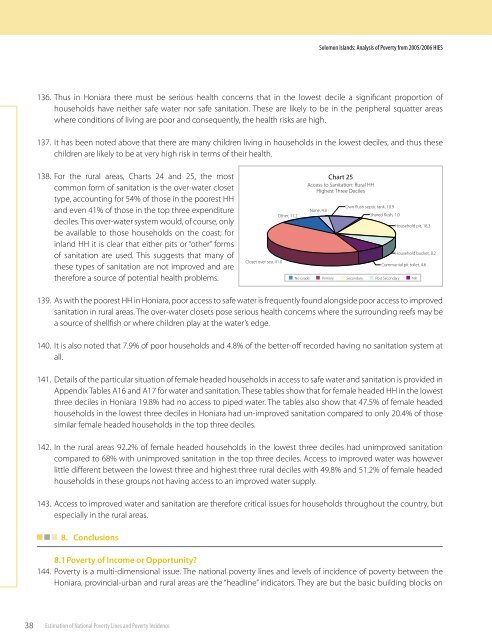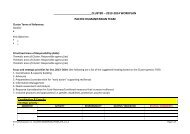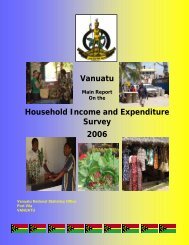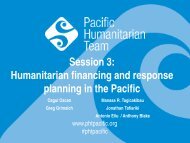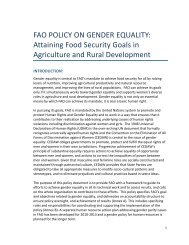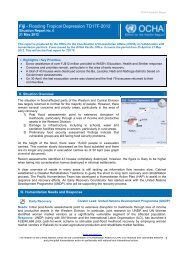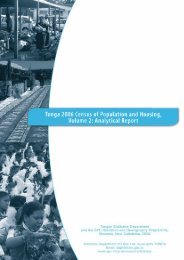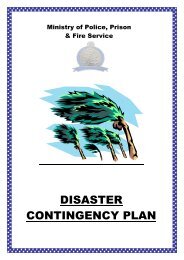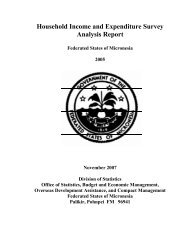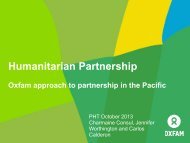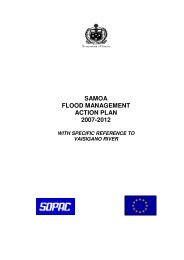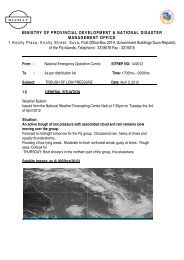Solomon Islands - Asia & the Pacific
Solomon Islands - Asia & the Pacific
Solomon Islands - Asia & the Pacific
Create successful ePaper yourself
Turn your PDF publications into a flip-book with our unique Google optimized e-Paper software.
<strong>Solomon</strong> <strong>Islands</strong>: Analysis of Poverty from 2005/2006 HIES136. Thus in Honiara <strong>the</strong>re must be serious health concerns that in <strong>the</strong> lowest decile a significant proportion ofhouseholds have nei<strong>the</strong>r safe water nor safe sanitation. These are likely to be in <strong>the</strong> peripheral squatter areaswhere conditions of living are poor and consequently, <strong>the</strong> health risks are high.137. It has been noted above that <strong>the</strong>re are many children living in households in <strong>the</strong> lowest deciles, and thus <strong>the</strong>sechildren are likely to be at very high risk in terms of <strong>the</strong>ir health.138. For <strong>the</strong> rural areas, Charts 24 and 25, <strong>the</strong> mostcommon form of sanitation is <strong>the</strong> over-water closettype, accounting for 54% of those in <strong>the</strong> poorest HHand even 41% of those in <strong>the</strong> top three expendituredeciles. This over-water system would, of course, onlybe available to those households on <strong>the</strong> coast; forinland HH it is clear that ei<strong>the</strong>r pits or “o<strong>the</strong>r” formsof sanitation are used. This suggests that many of<strong>the</strong>se types of sanitation are not improved and are<strong>the</strong>refore a source of potential health problems.Closet over sea, 41.0O<strong>the</strong>r, 11.2Chart 25Access to Sanitation: Rural HHHighest Three DecilesNone, 4.8Own flush septic tank, 10.9Shared flush, 1.0Household pit, 18.3Household bucket, 8.2Communial pit toilet, 4.6No Grade Primary Secondary Post Secondary NR139. As with <strong>the</strong> poorest HH in Honiara, poor access to safe water is frequently found alongside poor access to improvedsanitation in rural areas. The over-water closets pose serious health concerns where <strong>the</strong> surrounding reefs may bea source of shellfish or where children play at <strong>the</strong> water’s edge.140. It is also noted that 7.9% of poor households and 4.8% of <strong>the</strong> better-off recorded having no sanitation system atall.141. Details of <strong>the</strong> particular situation of female headed households in access to safe water and sanitation is provided inAppendix Tables A16 and A17 for water and sanitation. These tables show that for female headed HH in <strong>the</strong> lowestthree deciles in Honiara 19.8% had no access to piped water. The tables also show that 47.5% of female headedhouseholds in <strong>the</strong> lowest three deciles in Honiara had un-improved sanitation compared to only 20.4% of thosesimilar female headed households in <strong>the</strong> top three deciles.142. In <strong>the</strong> rural areas 92.2% of female headed households in <strong>the</strong> lowest three deciles had unimproved sanitationcompared to 68% with unimproved sanitation in <strong>the</strong> top three deciles. Access to improved water was howeverlittle different between <strong>the</strong> lowest three and highest three rural deciles with 49.8% and 51.2% of female headedhouseholds in <strong>the</strong>se groups not having access to an improved water supply.143. Access to improved water and sanitation are <strong>the</strong>refore critical issues for households throughout <strong>the</strong> country, butespecially in <strong>the</strong> rural areas.8. Conclusions8.1 Poverty of Income or Opportunity?144. Poverty is a multi-dimensional issue. The national poverty lines and levels of incidence of poverty between <strong>the</strong>Honiara, provincial-urban and rural areas are <strong>the</strong> “headline” indicators. They are but <strong>the</strong> basic building blocks on38Estimation of National Poverty Lines and Poverty Incidence


